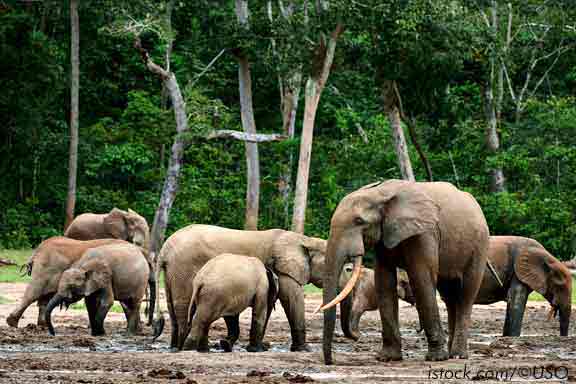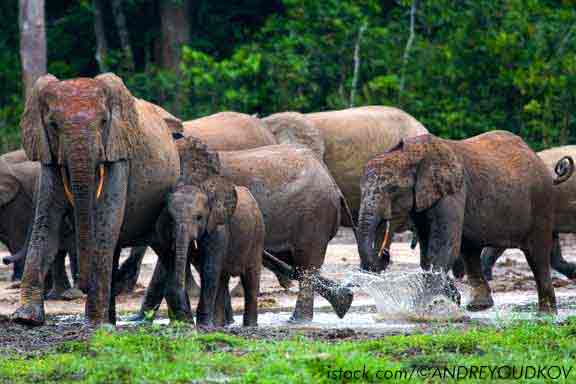The forest elephant, Loxodonta cyclotis, lives in the tropical areas of Central Africa and West Africa. It is only found in larger numbers in Gabon, Cameroon, the Republic of Congo and Liberia. Protecting these populations is not only critical to the future of the species in Central and West Africa, but it is also important for the climate.
The African forest elephant is less well known than the savanna elephant in East or South Africa. Ecological and political obstacles and its sometimes inaccessible habitat make it difficult to study and protect. For a long time, forest elephants were not considered a distinct species. But genetic studies show that the forest elephant is distinctly different from its savannah cousin.
It is smaller and darker in color, generally has smaller, rounder ears and thinner, straighter tusks. It usually lives in small groups of 2 to 3 individuals. An additional conservation concern is that forest elephants have longer reproductive cycles than savanna elephants: Forest elephants are the slowest reproducing elephants. Cows do not give birth to offspring until they are 23 years old, and then only every 5-6 years, about 5-6 babies. So doubling the population would take about 60 years[1]. Savannah elephant cows have their first offspring at about 12 years of age.
Forest elephants are climate protectors.
They combat climate change by contributing to natural carbon sequestration. Their dung contains various tree and shrub seeds. The animals distribute these over long distances, thereby creating food and shelter for numerous other animal species. Biodiversity is thus demonstrably strengthened. In addition, the pachyderms clear the tropical forests around the Congo Basin of overgrown bushes - hence their reputation as valuable landscape gardeners: the remaining trees benefit from more space and better access to water and light. This has a positive effect on plant growth. The larger a tree is, the more carbon it can store. The disappearance of forest elephants could potentially accelerate climate change.
Researchers have discovered something astonishing: According to them, it's thanks to the pachyderms' animal input that Africa's rainforests have even been shown to store more carbon than the world's largest Amazon rainforest.[2]
And simulations show: In a world without forest elephants, about seven percent plant mass would be permanently lost. That's equivalent to about three billion metric tons of carbon. The cost of artificially storing this excess carbon would be enormous, at around 36 billion euros.[3]
The threat
The sharp decline of forest elephants in Central Africa is largely a result of unprecedented levels of poaching for the illegal ivory trade in recent years. They are also threatened by the loss of their territory by humans. Because of deforestation of the rainforest (logging, cultivation of cocoa or palm oil plantations), their habitat is now up to 75 percent smaller than it was originally. In the Ivory Coast, for example, there are only about 200 elephants left today [4].
However, forest elephants may still face another threat. Global warming is having a measurable impact on the fruit production of virgin forest trees. According to recent studies in the "Lope National Park" in Gabon, this has fallen by around 80 percent in the past 30 years. Starving forest elephants are increasingly leaving the jungle in search of edibles - and coming into conflict with humans there[5].
Forest elephants are even more endangered than savannah elephants because their slightly pink shimmering tusks are made of even harder ivory, can be carved with greater filigree and are therefore particularly prized by ivory traders.
Another threat to the shy forest dwellers is trophy hunting, which is still allowed in Cameroon, for example, despite the threat. In 2013, researchers found that total forest elephant populations in Africa had fallen 65 percent since 2002. Originally there were around 1.1 million forest elephants, today only 5 to 10%.
A new IUCN Status Report is currently underway and will for the first time include separate figures for both elephant species of Africa (the recognition of the African forest elephant as a separate species by the IUCN did not take place until the end of March 2021, placing it directly on the "red list" of "acutely endangered" species).
It is now up to us humans to quickly find sustainable solutions to ensure the survival of forest elephants. This involves an end to the global ivory trade, the fight against poaching and the protection of habitats.
Future for Elephants supports these projects for forest elephant conservation, among others:
Sources:
[1] https://www.wissenschaft.de/umwelt-natur/waldelefanten-leben-langsam/ (GERMAN)
[2] Nature Geoscience: "Carbon stocks in central African forests enhanced by elephant disturbance"
[3] Nature Geoscience: "Amazon forest response to CO2 fertilization dependent on plant phosphorus acquisition"
[4] https://www.france24.com/en/live-news/20210428-ivory-coast-sounds-alarm-over-plunging-elephant-population
[5] https://www.fr.de/panorama/klimawandel-waldelefanten-bedroht-dickhaeuter-wilderei-savanne-afrika-90263510.html




